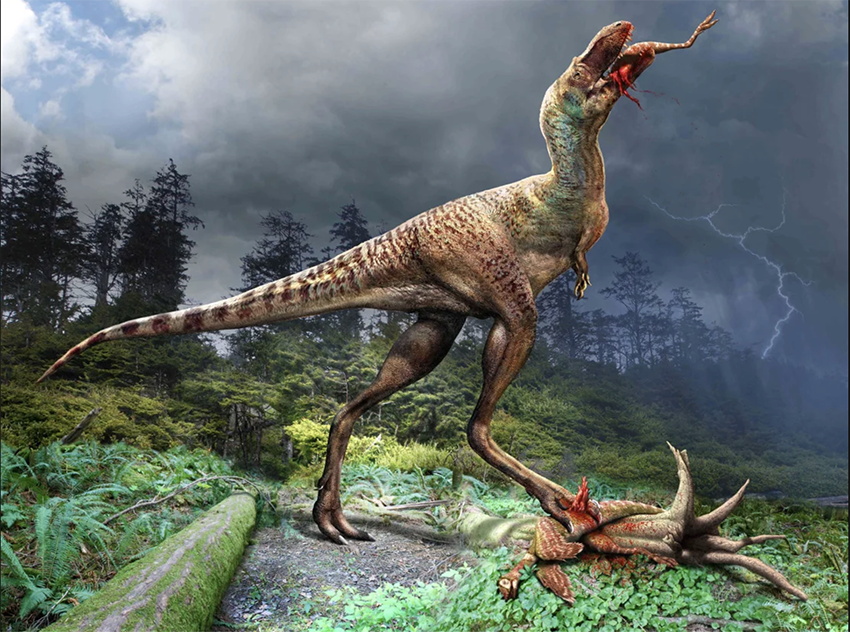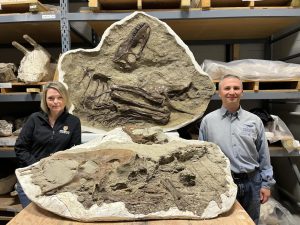
Last Supper of a Young Gorgosaurus
The dietary habits of dinosaurs, the captivating prehistoric creatures, have intrigued researchers for years. Dinosaur fossils, entombed in the depths of prehistory, have maintained their enigmatic allure for millions of years, and continue to fuel the imagination of scientists. Despite ongoing revelations about the lives of these colossal beings through the fossil record, details about their “last meals” remain significantly scarce. This scarcity arises from the fact that even a fully preserved skeleton is a rare find, and the contents of the stomach are frequently lost to the passages of time.
In a study published in December 2022, scientists had revealed that the stomach of a microraptor (Microraptor zhaoianus) fossil discovered in China contained the preserved foot of a small, rodent-like mammal. This finding marked the 21st specimen with intact stomach contents, and notably, it was the first instance indicating that microraptors also consumed small mammals.
A recent study, published in Science Advances, has now brought attention to rare data derived from the stomach contents of a tyrannosaur-like dinosaur (tyrannosaurid) fossil, unveiling evidence of an exclusive diet dating back 75 million years. The study sheds light on an extraordinary occurrence where a young dinosaur seemingly “snacked” on the hind legs of two baby dinosaurs.
Tyrannosaurs were formidable predators that dominated the late Cretaceous period. The newly found fossil belongs to a Gorgosaurus libratus, a cousin of the renowned and colossal T. Rex. This particular fossil, belonging to a juvenile aged 5-7 years, weighs approximately 350 kilograms and measures 4 metres in length. Unearthed in Alberta, Canada, in 2009, this exceptionally well-preserved specimen provides a rare glimpse into the dietary behaviours of dinosaurs.
Researchers highlight the scarcity of concrete evidence regarding dinosaur diets, making this fossil of particular significance. Moreover, it represents the inaugural instance of a tyrannosaur stomach contents being preserved “in situ,” meaning in the correct anatomical position. Consequently, these findings bridge a crucial knowledge gap concerning the dietary preferences of young tyrannosaurs.

Estimates, derived from the length of the femur (upper leg bone), indicate that the dinosaur weighed around 335 kilograms and constituted a mere 13% of the mass of an adult of the same species. The remnants of the young Gorgosaurus‘s last two meals consist of the hind legs of two distinct individuals of Citipes elegans, a small theropod.
The study authors inferred from the observed differences in fragmentation and acid erosion that one of these individuals may have been consumed hours or days prior to the other. Interestingly, both individuals had not undergone sufficient digestion at the time of the young Gorgosaurus‘s demise. The presence of acid etching suggests a unique digestive process wherein these creatures broke down and digested the bones of their prey, as opposed to regurgitating them.
The estimated body weight of the two consumed Citipes individuals falls within the range of 9-12 kilograms, and histological examinations of their bones indicate that both were in their first year of life when they perished. The intriguing aspect is that these two animals, being of the same species, age, and size, were chosen as prey at different times. This suggests that the young Gorgosaurus displayed discerning taste and a selective dietary preference, rather than these instances being accidental consumptions.
Based on the modelling of prey and predator size, scientists assume that young tyrannosaurs, including Gorgosaurus, would transition from consuming small prey such as insects, amphibians, and lizards to larger prey with masses closer to their own body weight after reaching 16-32 kilograms. However, the discovery challenges this prediction, as the young Gorgosaurus, weighing around 335 kilograms -well beyond the predicted threshold, continued to feed on small dinosaur species. This indicates that, contrary to expectations, small prey remained attractive to these young predators even as they grew larger.
Researchers attribute the shifts in the hunting strategies of young Gorgosaurus to the development and changes in the skull and tooth structure as they progressed into adulthood. These adaptations suggest that the young tyrannosaurus altered its prey preferences in tandem with increasing body mass, eventually opting for prey closer to its own size. These evolutionary adjustments appear to have allowed tyrannosaurs to adopt a distinctive feeding strategy that persisted throughout their lives.
This remarkable research once again underscores the power of science by directly unveiling a dietary snapshot from 75 million years ago. The final meals of the young Gorgosaurus provide profound insights into dinosaur diet and evolution, showcasing the extent to which science can unravel the mysteries of the past. The data generated by this discovery triggers scientists to pose new questions, fostering a deeper understanding and exploration of the creatures and ecosystems from 75 million years ago. While this significant finding propels advancements in palaeontology, each detail uncovered about the natural history contributes to a richer comprehension of life and ecosystems as they exist today.
REFERENCES
- 1. https://edition.cnn.com/2022/12/26/world/dinosaur-mammal-last-meal-scn/index.html
- 2. https://edition.cnn.com/2023/12/08/americas/tyrannosaur-fossil-discovery-scn/index.html
- 3. https://www.smithsonianmag.com/science-nature/amazing-fossil-preserves-teenage-tyrannosaurs-last-meal-180983398/
